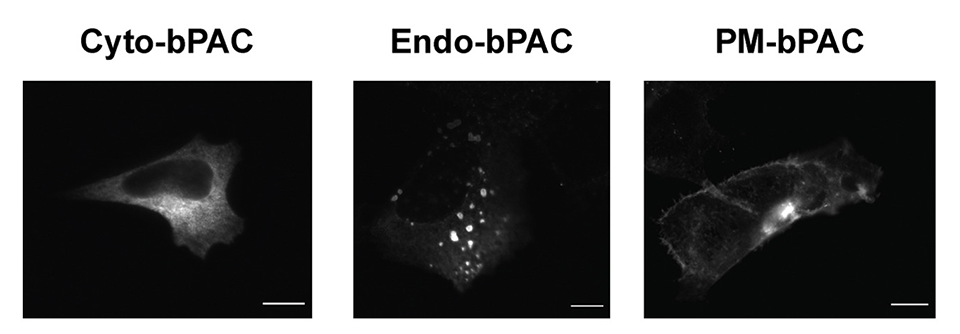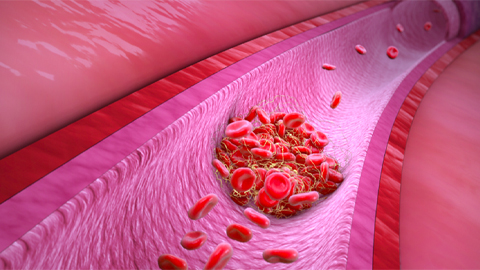cAMP: Mapping a second messenger
Cyclic adenosine 3,5-monophosphate, known as cAMP, acts as what the Nobel prize–winning neuroscientist Paul Greengard called a “second messenger” in regulating cellular functions such as growth and specialization, protein expression, and gene transcription by relaying extracellular signals to the cell’s interior.
In disease, intracellular pathways control cytokine secretion, resistance to toxins and pathological events by balancing the activity of enzymes, which adjust intracellular cAMP levels. Researchers recently have recognized that receptors can regulate cAMP production not only from the cell surface but also from intracellular membranes.
cAMP can diffuse rapidly, but under normal conditions, its concentration varies from place to place within a cell. It can cause highly localized downstream effects, suggesting that cellular compartmentalization underlines selective cellular responses. To investigate the impact of cAMP production when initiated from endocytic vesicles, a team led by Nikoleta Tsvetanova of Duke University and Mark von Zastrow of the University of California, San Francisco, used localized optical stimulation of cAMP synthesis and quantitative mass spectrometry to determine how compartmentalized cAMP production impacts downstream responses assessed through protein phosphorylation. Their study was published in the Journal of Biological Chemistry.

“We sought to determine the overall functional significance of generating cAMP from internal membranes relative to the plasma membrane,” von Zastrow said.
The researchers seek to delineate the fundamental principles by which cells and tissues mount physiologically appropriate responses to a range of external and internal chemical inputs. They also are investigating the cellular basis of receptor-mediated drug action to identify paths for improving therapeutic efficacy.
“The first main takeaway is that generating cAMP from endosomes has widespread downstream effects,” von Zastrow said. “We initially thought we’d see only a small number of differences, but we identified many changes in the cellular phosphoproteome that result from endosome-generated cAMP relative to cAMP generated from the plasma membrane.”
The authors shed light on a less understood cellular signaling aspect: Location-encoded signaling is not restricted to increased protein phosphorylation or to effects mediated by the activity of a cAMP-dependent protein kinase such as protein kinase A, or PKA, in the nucleus. cAMP binds with and activates PKA, which then phosphorylates the protein to elicit cellular reactions.
The study also identified proteins that are dephosphorylated selectively in response to endosome-localized cAMP production and in sequences that do not correspond to PKA consensus sites. “Broadly speaking, our results show that producing cAMP from endosomes has potential to fundamentally ‘re-wire’ downstream cellular signaling by phosphorylation,” von Zastrow said.
The researchers were fascinated to see how multiple proteins are phosphorylated preferentially in response to cAMP produced from endosomes and to see proteins that are dephosphorylated selectively on distinct sites relative to those phosphorylated by PKA. Their cell culture model had tightly controlled variables, so the team cautions against directly extending their results to physiological systems or therapeutics. However, there are potentially profound biomedical implications for future studies.
This collaborative project involved researchers with various backgrounds, and each had different expectations, von Zastrow said. “Dr. Tsvetanova and I would frequently place bets on what results would be obtained. The data was so rich and clear that each one of us was surprised — to the degree that we generally forgot what the original bets were in the first place.”
Enjoy reading ASBMB Today?
Become a member to receive the print edition monthly and the digital edition weekly.
Learn moreGet the latest from ASBMB Today
Enter your email address, and we’ll send you a weekly email with recent articles, interviews and more.
Latest in Science
Science highlights or most popular articles
Universal tool for tracking cell-to-cell interactions
A team of researchers has developed LIPSTIC, which can lay the groundwork for a dynamic map tracking physical interactions between different cells — the elusive cellular interactome.

Weedy rice gets competitive boost from its wild neighbors
Rice feeds the world. But researchers have found that a look-alike weed has many ways of getting ahead.

From the journals: JLR
A “T” makes a difference in blood clotting. High cholesterol: two screens are better than one. Biomarkers for cardiovascular risk. Statin-induced changes to the HDL lipidome. Read about recent papers on these topics.

Decoding microglial language
Emory University scientists characterize extracellular vesicles that facilitate intercellular communication.

What is metabolism?
A biochemist explains how different people convert energy differently – and why that matters for your health.

What’s next in the Ozempic era?
Diabetes, weight loss and now heart health: A new family of drugs is changing the way scientists are thinking about obesity — and more uses are on the horizon.

